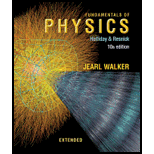
Concept explainers
To find:
the conservation laws that are violated for an electron to decay into two neutrinos, from a given list of conservation laws.
Answer to Problem 1Q
Solution:
An electron cannot decay into two neutrinos because this decay violates
Explanation of Solution
Given:
The list of conservation laws that are given is:
a) Energy
b) Angular momentum
c) Charge
d) Lepton number
e) Linear momentum
f) Baryon number
When you look at this equation
e- ![]() ν + ν
ν + ν
you will immediately see that the charge, and the lepton number conservation laws are violated. But there are other laws that are violated too.
Let us look at the conservation laws in details:
i. If you look at the angular momentum (spin) both, an electron and a neutrino have spin ½; hence (b) that is angular momentum conservation law is violated.
ii. Neutrinos carry no charge, hence (c) that is charge conservation law is not obeyed.
iii. Lepton number of an electron is +1, and for neutrinos is +1 too, hence (d) that is lepton number conservation law is violated. Even if you consider antineutrino-neutrino pair on the right hand side, the lepton number conservation law will be violated.
iv. Electrons and neutrinos are leptons and not baryons; thus the baryon number conservation law (f) does not come into picture at all.
We cannot say anything about the energy and linear momentum conservation laws because electron anyway does not decay into two neutrinos.
Conclusion
Theoretically, a charge is always conserved and thus electron is a completely stable particle.
Want to see more full solutions like this?
Chapter 44 Solutions
Fundamentals of Physics Extended
 Principles of Physics: A Calculus-Based TextPhysicsISBN:9781133104261Author:Raymond A. Serway, John W. JewettPublisher:Cengage Learning
Principles of Physics: A Calculus-Based TextPhysicsISBN:9781133104261Author:Raymond A. Serway, John W. JewettPublisher:Cengage Learning College PhysicsPhysicsISBN:9781938168000Author:Paul Peter Urone, Roger HinrichsPublisher:OpenStax College
College PhysicsPhysicsISBN:9781938168000Author:Paul Peter Urone, Roger HinrichsPublisher:OpenStax College College PhysicsPhysicsISBN:9781305952300Author:Raymond A. Serway, Chris VuillePublisher:Cengage Learning
College PhysicsPhysicsISBN:9781305952300Author:Raymond A. Serway, Chris VuillePublisher:Cengage Learning Physics for Scientists and Engineers with Modern ...PhysicsISBN:9781337553292Author:Raymond A. Serway, John W. JewettPublisher:Cengage Learning
Physics for Scientists and Engineers with Modern ...PhysicsISBN:9781337553292Author:Raymond A. Serway, John W. JewettPublisher:Cengage Learning Modern PhysicsPhysicsISBN:9781111794378Author:Raymond A. Serway, Clement J. Moses, Curt A. MoyerPublisher:Cengage Learning
Modern PhysicsPhysicsISBN:9781111794378Author:Raymond A. Serway, Clement J. Moses, Curt A. MoyerPublisher:Cengage Learning College PhysicsPhysicsISBN:9781285737027Author:Raymond A. Serway, Chris VuillePublisher:Cengage Learning
College PhysicsPhysicsISBN:9781285737027Author:Raymond A. Serway, Chris VuillePublisher:Cengage Learning





